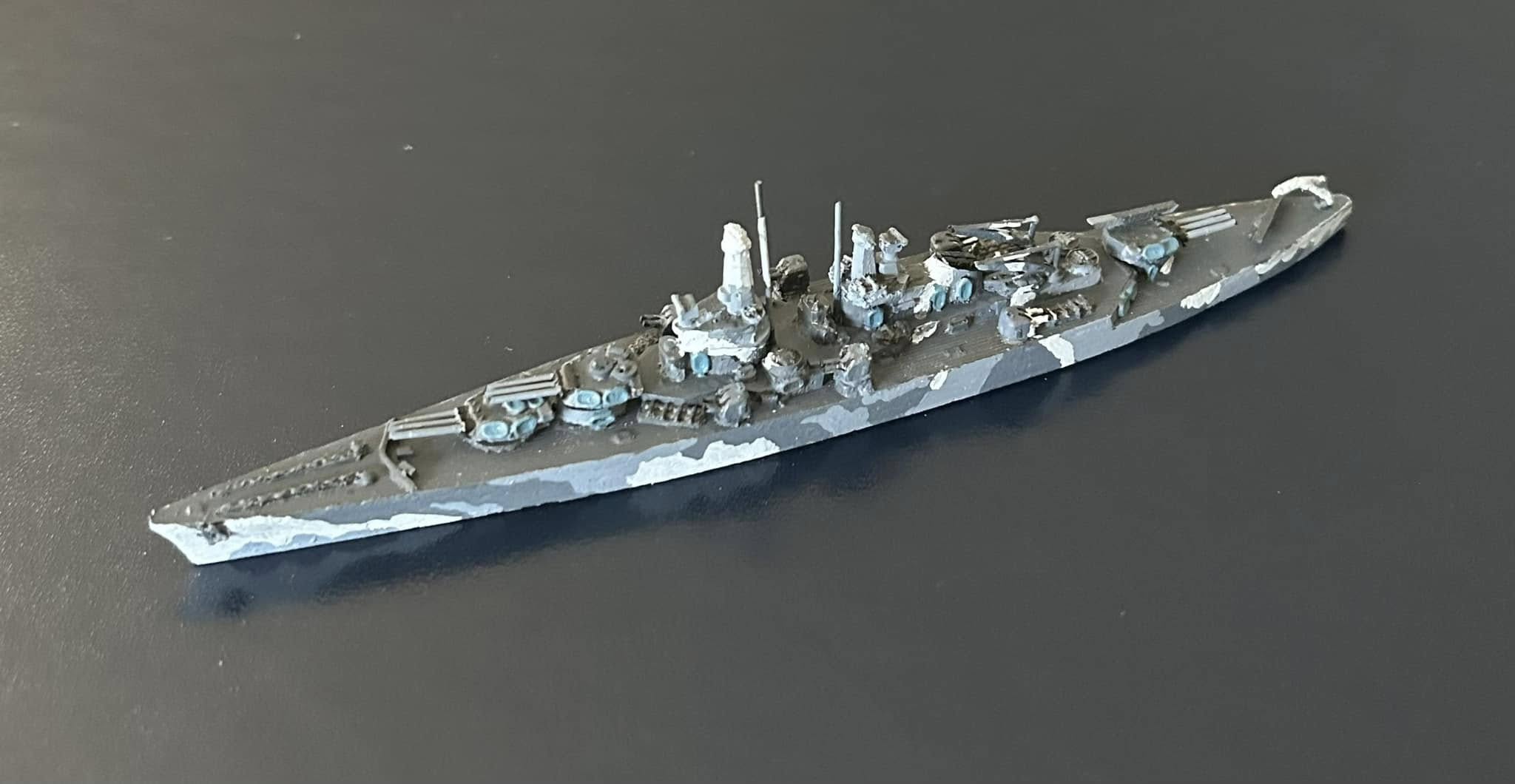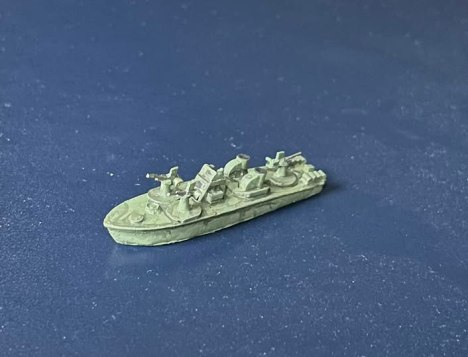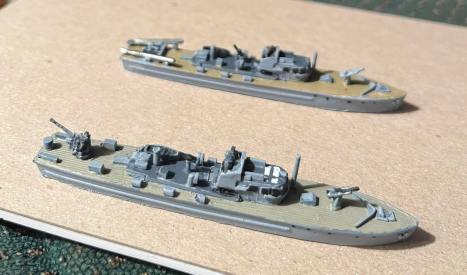At the beginning of the Second World War, coastal forces were mostly viewed as a novelty among the worlds navies. A few nations, like Germany and Italy, made serious efforts to develop small, fast, torpedo delivering vessels while lesser navies bought MTBs from other countries as a primary part of their diminutive naval resources. The larger navies tended to shy away from developing coastal craft in the 1930s, both for financial reasons and the influence of “traditional” elements in the command structure.
Great Britains Royal Navy started out with a motley collection of leftover MTBs built by Vosper, Thornycroft and British Power Boat (BPB). They also created small, anti submarine boats, MA/SB, for inshore sub hunting. No thought was given to tactics for these craft, as the Admiralty considered them more of an annoyance than an asset. With the fall of France in 1940, England suddenly found German coastal shipping just across the channel, while German Schnellboote raids started sinking ships off their east coast. The Royal Navy quickly embarked on a crash program to develop small warships while the existing forces painfully developed tactics by bloody trial and error. The MA/SBs were re-armed as Motor Gunboats (MGB) specifically to combat the German S-Boats (which the British had dubbed “E-boats”). The war in the English Channel resulted in rapid weapons development on both sides. Machine guns were replaced by 20mm cannons, which were later superseded by guns such as 40mm Bofors and automatic 6pdr.
The Germans also increased the armament and armor on their big Schnellboats, which already had a considerable advantage over their Allied counterparts. The S-boats were over 100 feet long and displaced roughly twice as much as the British Vospers. They were built with metal hulls (with wooden framing) and were powered by three high performance diesel engines. The use of diesels gave the German boats a considerable advantage in that fuel tanks full of diesel oil are much less likely to turn into a fireball when hit than the Allied boats which used high octane aviation gasoline. The round bottom S-boats also could maintain high speeds in rough water much better than the flat chine hulls of most MTBs. The better engines and hull shape resulted in the S-boats being very elusive during the first three years of the war. When they were caught , they usually outgunned the early MTBs and MGBs. Late war boats were also armored and very heavily armed. While very few S-boats had any kind of radar, many had Naxos radar detection units that could give warning of Allied boats tracking them. Both sides also employed larger vessels for escort and “hunter/killer” duty. Britain used the “Hunt” class destroyers for much of the Channel work, modifying some with a “bowchaser” 2pdr “pom pom” specifically for anti-E-boat work. Germany used their M-class minesweepers to excellent advantage in the escort role in both the Channel and in the Baltic.
Another deadly foe of the MTBs was the MFP, or “F-lighter ” landing craft used by Germany for coastal resupply primarily in the Mediterranean and the Black Sea/ Baltic fronts. These 170 foot ships carried light and heavy flak weapons in addition to cargo. As the war went on, some were modified into AFP artillery carriers, loosely known by the Allies as “Flaklighters”. These vessels were bristling with 20mm quads, 37mm guns and usually 2 large 3.5 or 4.1 guns. They were very heavily armored with steel and concrete. This armor, however, made them unbalanced, and a few flaklighters capsized from near miss bomb explosions. The MFP/AFP classes were also very hard to torpedo as they only drew about 3-5 feet of water, depending on their loading. Allied MTBs were not effective against these craft until the arrival of the British MkVIII torpedoes in 1944. These were fitted with effective magnetic exploders that detonated the warheads as they passed underneath the shallow draft F-lighters. British MTB flotillas racked up many sinkings of F-lighters with these torpedoes once they arrived.
All nations also developed “Motor Launch” type vessels, all around 100 long, all traveling about 18kts tops. British “MLs, German “R-Boats”, Italian “VAS”, U.S. “SC” sub chasers and Soviet “MO” craft all fall under this category. These were used as escorts, minesweepers, minelayers and sometimes as strike craft, although their low speed made it difficult to sortie to and from enemy waters. Soviet launches often served as landing craft as they had few purpose built vessels of this type. A few British Fairmile B Motor Launches , German R-boats and Finnish VMV launches were sometimes fitted with torpedo tubes, although their slow speed precluded their use as MTBs and boats modified in this way saw little action.
The most common escort for both sides was the lowly modified fishing trawler. These were pressed into service by the score by all combatants (except the US). By far, these were the most common escorts used in the Channel by England and Germany. By the end of the war, German trawlers were hornets nests of light cannon, eliciting much respect from Allied Coastal Forces. While these craft, too, suffered from an almost total lack of radar, they would often use their hydrophone listening gear to detect the approach of Allied coastal forces.
The U.S. Navy started developing Patrol Torpedo (PT) boats just before World War Two. When America entered the war in late 1941, she had a few squadrons of 77 Elco boats, which were directly based on a British Scott-Paine design. As the war went on, Elco 80 and Higgens 78 boats joined the ranks. The PTs in the Pacific soon found their primary targets were Japanese barges, and torpedoes gave way to 37mm guns and eventually rockets as the primary weapons. In this task they had to contend with Japanese shore batteries, unmarked reefs and escorting float planes in addition to weapons mounted on the barges themselves. Sometimes, the water near the islands had a phosphorescent quality that caused the wake of a lurking PT to actually glow! In the Mediterranean PTs fought primarily against German MFPs and AFPs. Heavy torpedo launch tubes were discarded for roll-off racks, enabling installation of 40mm Bofors and, in a few 80Elcos, a quad 20MM “Thunderbolt”. In both theaters American boats had a great advantage in their superior radar. Before 1944 this advantage was often to no avail as the early tube-fired Mark 8 torpedoes were hopelessly ineffective. Many British accounts of US boats seem to indicate that they launched their torpedoes at a far greater range than their British cousins, resulting in fewer hits.
Other countries, too developed the torpedo boat for their use. Italy, who pioneered the use of the MTB in World War I, Developed both small, fast “MAS” boats and larger “MS” boats based on the German S-boats. While not recognized by many Allied historians, MAS boats were the elite of the Italian Navy. In one night, several boats sank over 30,000 tons of shipping in the Pedestal convoy to Malta. After the surrender, MAS and MS boats served on both sides for the remainder of the war. Italy also utilized MTM explosive boats , small craft that actually rammed their targets after the one man crew bailed out, detonation an explosive charge in the hull. Another boat, the MTSM, was a small two man boat with a single torpedo (stern launched) and two depthcharges. These craft, operated 1944-45 by the RSI Fascist Italian X MAS flotilla, sank an LST and severely damaged a French destroyer in addition to fighting US PCs and French manned SCs on many occasions.
Of all the coastal fleets of the war, that of the Soviet Union perhaps had the strangest collection of craft. Starting in the mid 1930s, Russia built scores of small, very fast aluminum G-5 MTBs . Based on the old CMBs with stern launching torpedoes, these boats attacked en mass, usually lost a boat or two in the process, and seldom hit anything. Stern launched torpedoes demanded high speed attacks, so the stealth tactics developed by other navies were not an option.Their aluminum hulls, the design of which was based on float-plane pontoons, deteriorated in the salt water and they had to be moored up river or taken out of the salt water. Many mounted 82mm rocket launchers, these being used more for support of ground troops than against shipping. Many were actually lost in collisions and several were captured by Axis forces in the Black sea and Gulf of Finland. Larger wooden hull D-3 boats were also made along with various steel hull prototypes. One of these, the SM-3, sank several Axis vessels in the Black Sea including an Italian sub! The Russians also had many lend-lease PT and Vospers. While their MTBs were unspectacular, the Soviet Navy developed small armored gunboats to a science. The 1124 and 1125 classes were heavily armored and had tank turrets mounted on the hull. Some mounted “Katyuska” multiple rocket launchers. These river tanks as they were called only drew 2 of water and were also used as landing craft for naval commandos.
Coastal warfare in the Black Sea and the Baltic has not received much attention. Italian MAS boats sank a Soviet Cruiser in the Black Sea. Along the Crimean coast, battles between Axis MFPs, S-boats and R-boats against Soviet MTBs and motor launches approached ferocity seldom seen in other waters. Finland used a handful of obsolete boats initially with telling effect on Soviet shipping. As the war went on, Italian MAS boats and some captured Russian vessels were added to the Finnish Navy inventory. Action was seen on both Lake Ladoga and the Baltic, with mines being the weapon of choice by both sides. By 1944, the Gulf of Finland was the most densely mined body of water in the world.
Japan, despite excellent efforts in the rest of naval development, never pursued MTB development with much energy. Some small boats were built but few actions were engaged in. Japanese coastal craft were primarily 50-70 barges, heavily armed and armored. France also built very few boats. These craft, called VTBs, saw virtually no action, with only a handful escaping to Britain in 1940 to be later used in clandestine agent drop missions or conversion to MGBs. French “chasseur” sub chasers were used by the Free French in the Channel, one being the first French ship to enter a French port right after the invasion in 1944.
Mines were a major influence in coastal operations. Minefields would keep larger enemy ships away from coastal shipping lanes. MTBs could usually skim over these minefields, but not always. Both sides would work to cover minesweeping of enemy mines while preventing that from happening to their minefields. One must bear in mind that in mmost theaters mines accounted for more sinkings than any other cause. All four US PTs lost in the Mediterranean were mine victims.
After the war, most navies disposed of their coastal craft. The US and USSR sold many to allied nations, while smaller nations like Israel and Egypt again put coastal craft to use in the 1967 Six Day war.
Filed under: Historical Info | Leave a comment »



























You must be logged in to post a comment.